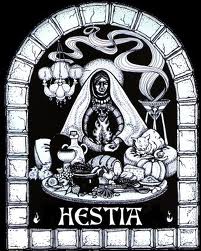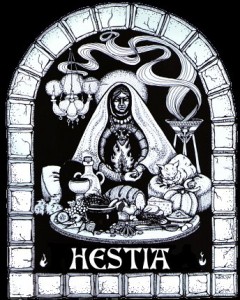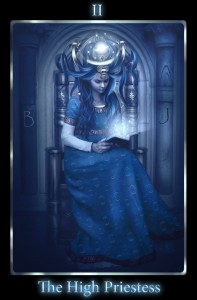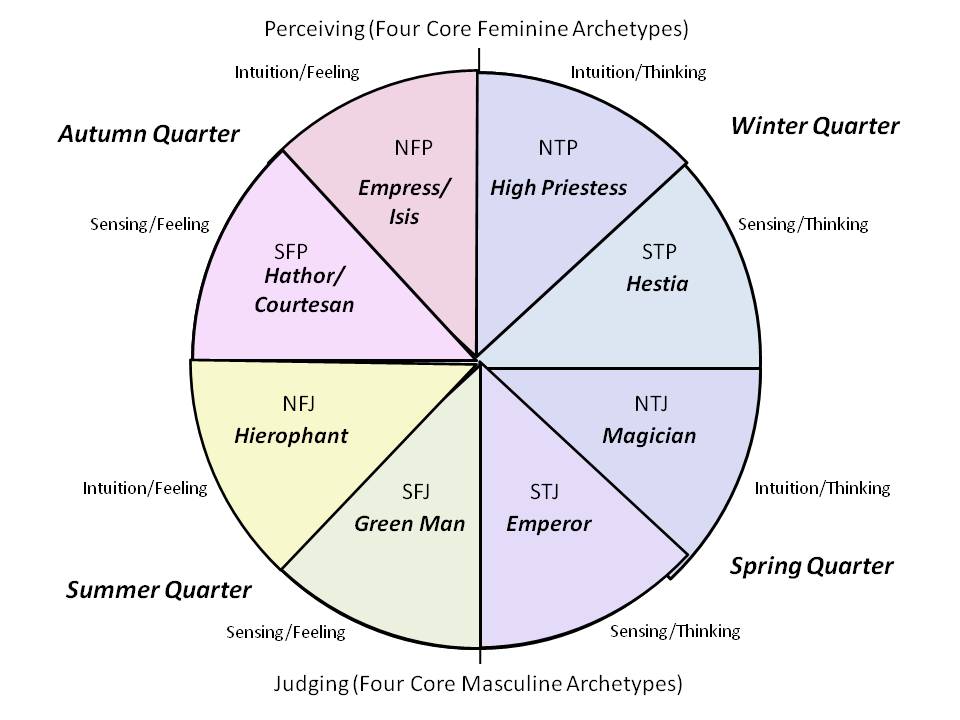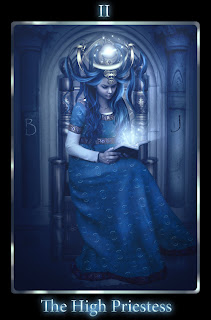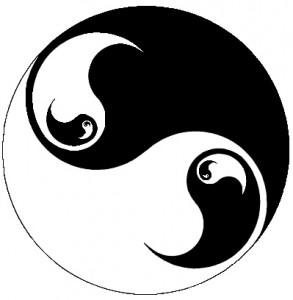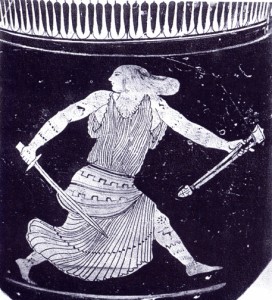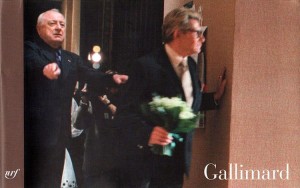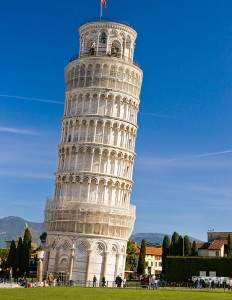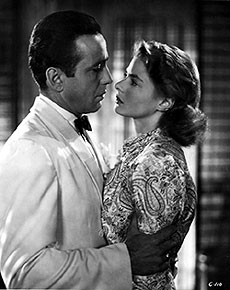Hestia, the Goddess-Archetype of Hearth and Home, Keeps Life Glued Together
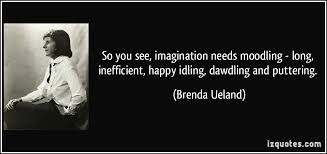
Puttering about – essential to unlocking our creative gifts, quote from Brenda Ueland.
Puttering is vastly underrated.
I took three days off from my usual schedule this last weekend. On one of these, I got a new project started – with alacrity and focus that surprised even me. The other two days?
Puttering.
After a long, cold winter (which is likely to be longer and colder; the groundhog definitely saw his shadow), we’re having more light.
More light is not only increased energy, its more light on the cobwebs and dusty corners; the piles of paperwork, every little thing that piled up while we were busy getting through the holidays, and then hibernating for the weeks of Solstice and immediately thereafter.
This was our High Priestess time.
Our High Priestess Time Is for Introspection and Inspiration
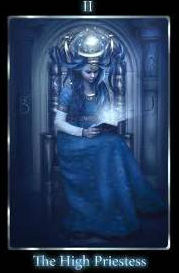
The High Priestess, by Mari-Na.
In our High Priestess mode (still continuing, especially when we finish shoveling out and just want to take a long hot bath, sit in front of the fire, or curl up with a good book or DVD), the boundaries of our awareness are open, diffuse, and unfocused.
If we can manage not to overindulge in novels, DVDs, and Facebook surfing, then we are open to our inner wisdom and guidance. This is the time when connections happen; ideas and thoughts emerge that can influence us for years ahead.
Several years ago, we had a big winter blizzard, and were snowbound for three days. I used that time to study some notes and pull together some ideas that had been lurking in the corners of my mind. This led to the first patent that I wrote for my newly-formed company; it was a significant and over-arching invention in the new realm of knowledge discovery.
Vacations similarly help us access our inner High Priestess, and medical researchers suggest that vacations help promote creativity. There is even a study supporting a relationship between vacations and marital happiness and reduced depression!
Our Hestia Time Is for Getting Our Lives in Order
Vacations are important. Even snow days (once we’ve gotten home safely, and have done the requisite snow-shoveling) give us a little bubble of time-out-of-time. That’s what our High Priestess moments are all about.
But Lee G., one of my dear friends, once said:
5% of life is the highs. 5% is the lows. The rest is maintenance.
Our Hestia mode is all about maintenance.
Hestia is not as fun, exciting, or dramatic as our visionary and creative Magician. She doesn’t give us the same surge of taking-over-the-world as does our Emperor. She’s not about the feel-good times of our nurturing Empress or mentoring Hierophant. She’s very far removed from the dopamine-fueled, pleasure-seeking Hathor mode (our inner goddess of love, sensuality, and pleasure in all its forms).
But without our Hestia, life falls apart.
Hestia sews on buttons.
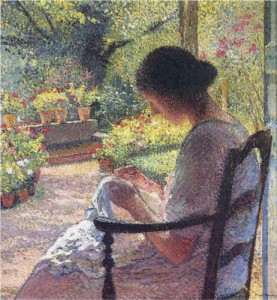
A Woman Sewing, by Henri Martin (French Post-Impressionist Painter, 1860-1943).
Recently, I wanted to get back into sewing.
Sewing is one of my favorite creative activities; I love the interplay of color, weave, sheen, and texture. I delight in the feel of fabrics. I love the technical challenge of making something beautiful and fitted, or something that drapes just so.
Hand-sewing is my own “wax on, wax off.” It’s one of the ways in which I access my inner High Priestess; the gentle rhythm of hand-sewing keeps my hands busy while my mind opens up. It’s one of my chief ways of encouraging creativity.
In short, sewing helps me access my High Priestess, which then helps me (because its creative, yet gives me quiet-time) access my inner Magician.
But sometimes, it’s hard for me to jump right into a creative project.
So this last time, to get my juices flowing, I tackled my mending basket.
Over the course of an afternoon, I replaced elastic, mended tears, and did lots of other little itsy-bitsy sewing chores, getting my hands and mind used to the rhythm once again.
Getting into my Hestia mode helped me access my High Priestess mode (when I actually started a for-real sewing project this last weekend), which was tied into my Magician. (The sewing project involved envisioning what I wanted, matching colors and fabrics, putting together accessories, etc.)
When I access my High Priestess and Magician on right-brain (sensory-rich, hands-on) projects, my mind starts to free up and get new ideas for the more logical, linear, left-brain areas.
Making the Most of Your Hestia Time
Some years ago, one of my dance students – whose day job was working at the Claude Moore Colonial Farm (a living history farm) says that she and the other lead staff figured out how to get the best out of volunteers.
Volunteers were easy to come by. Also, various schools would occasionally have students spend a day at the farm, getting a real-life taste of what it was like to live back in colonial times.
So, willing hands and strong bodies were not the problem.
The problem was getting them on a useful task.
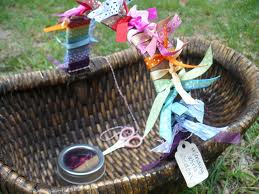
A mending basket is a tool for our Hestia time.
My student and her colleagues found that the ideal solution was to establish project boxes.
Every project box contains a written list of exactly what needs to be done, and all the tools/supplies needed to do the job.
I thought this was an excellent idea, and started using it for my own projects-about-the-house.
For example, my mending basket doesn’t just contain clothes to be mended. Each item is put into a plastic zippered bag, with a note about what has to be done, matching thread, and whatever other small items are needed. If I need to get something special to complete a task – a zipper or even the right color of thread – that goes on a special shopping list, and the zippered bag doesn’t go into the big mending basket until everything is there, ready-to-use.
When I take Hestia time, I don’t have to run around looking for the odds and ends needed to get a job done.
Try this at home, and see if it makes your life easier. (And let me know if it does – use the comments below)

